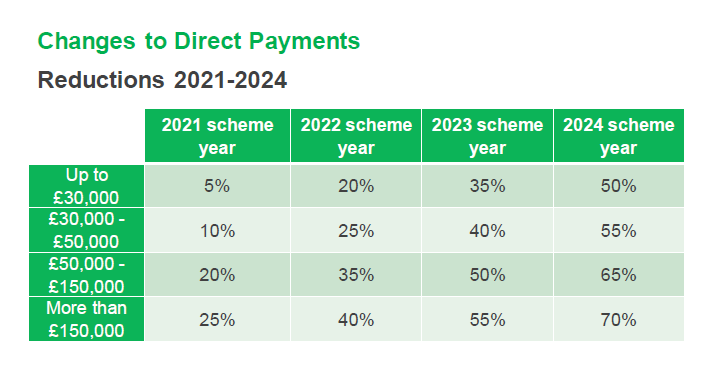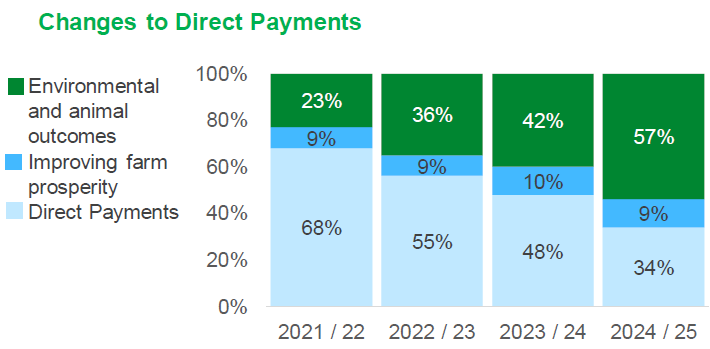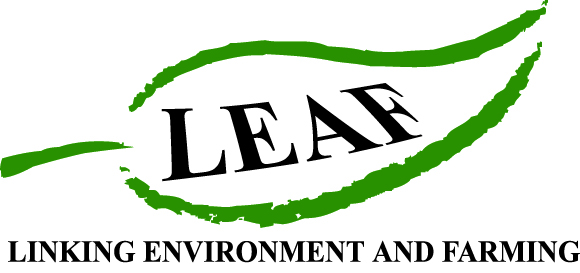 As has been increasingly publicised over the past few years, the agricultural payments system is moving fast away from area based direct payments - this can be seen in the table and graph to the right from the Agricultural Transition Plan presentation from Defra in December 2020.
As has been increasingly publicised over the past few years, the agricultural payments system is moving fast away from area based direct payments - this can be seen in the table and graph to the right from the Agricultural Transition Plan presentation from Defra in December 2020.
With reassurance that the same overall annual amount of money, approximately 3 billion pounds, will be available to support farm businesses at least until 2025, a set of new schemes including animal and tree health pathways, and productivity grants newly titled ‘Farming Investment Fund’ are under design for this to be accessed through. The intention is that the Environmental Land Management (ELM) scheme acts as a mechanism for delivering ‘public money for public goods’ within the ‘Future Farming and  Countryside Programme’. The stated six public goods intended to be paid for the provision of are, in line with the 25 Year Environment Plan:
Countryside Programme’. The stated six public goods intended to be paid for the provision of are, in line with the 25 Year Environment Plan:
- clean and plentiful water
- clean air
- protection from and mitigation of environmental hazards
- mitigation of and adaptation to climate change
- thriving plants and wildlife
- beauty, heritage and engagement
LEAF has been involved in the ‘co-design’ of the ELM scheme since 2019, alongside a wide range of other organisations including the Wildlife Trusts, NFU, TFA, CLA, RSPB, Heritage Alliance, National Trust, Local Government Association, Commons & Uplands Alliance, AIC and Soil Association to name but a few. As part of this process, we have consistently highlighted that the actions and outcomes that are represented through LEAF Marque certification are synonymous with the delivery of these public goods.
So where does LEAF in Penwith come in? Basically, our line is that Integrated Farm Management (IFM), which is robustly evidenced through the independently audited LEAF Marque Assurance, delivers on all the things intended for payment in ELM. Our input to Defra through the Tests & Trials Programme, within which we have been running four projects over the past 18 months, has included findings that:
- LEAF Marque Standard v.15.0 contains mandatory Control Points pertaining to the delivery of all 6 public goods intended for payment through the ELM scheme
- Actions represented in the LEAF Marque Standard have proven environmental performance impact, including conservation and biodiversity, Integrated Pest Management, soil quality, animal welfare, non-renewable resource use efficiency, community relations and water resource management
- The LEAF Sustainable Farming Review is a tried and tested tool to plan and record environmental actions and practical decisions within a whole farm system. It has potential to be adopted as a Land Management Plan for ELM
- The process of progression towards LEAF Marque certification brought additional benefits to participating farm businesses including carbon footprinting and cost savings through energy, water and nutrient use efficiency
The full reports and findings to date from LEAF’s T&Ts can be read here - they also include an investigation into the use of apps for self-assessment of public goods delivery, and LEAF Demonstration Farmers’ experience of whole farm planning. A fourth trial, looking at how the training that LEAF provides to farmers to facilitate farm visits by schools and other community groups can help in the provision of public engagement funded through ELM is due for completion in early summer. A summary of findings from the wider T&T programme up to July 2020 can be found here.
An important difference between old and new schemes is that as payments are not linked to acreage, sectors delivering public goods on smaller scales should be increasingly eligible for significant payment. In no sector could this be more relevant than in horticulture, which has benefited less than arable from the BPS scheme due to smaller areas of intensive production.
Three component levels of ELM are on the cards:

The Agricultural Transition Plan revealed at the end of last year lays out a timescale for rollout of this with Phase 1 of a National Pilot starting later this year, core elements of the Sustainable Farming Initiative (SFI) being introduced in 2022 (alongside Countryside Stewardship applications staying open to applications until 2023), and full scheme availability from 2024.
So we see two opportunities here for LEAF Marque farmers in Penwith. Firstly, through being certified for recognition at a standard either inherently rewarded through or equivalent to the SFI requirements. No-one yet knows exactly what the payment structure will be, but for Phase 1 of the Pilot it involves groups of actions under themes such as grassland, hedgerows, water bodies or woodland. Our recommendations to the design of these has been to recognise the value of existing paperwork and inspection mechanisms (such as LEAF Marque) to avoid the double inputting that costs time and acts as a barrier to involvement.
And secondly, more uniquely to Penwith, the opportunity to cluster together collaborating LEAF Marque farms to support qualification for the second tier, Local Nature Recovery. Great examples of farmer clusters, such as the Marlborough Downs Space for Nature Project in Wiltshire, have been recognised as an important model in this collaborative tier of ELM, and several T&Ts have been looking at the potential of such groupings.
So, change is in the air, but with 30 years of environmental land management experience by productive farm businesses, LEAF is ideally placed to embrace and embody the benefits. Integrating LEAF Marque into the landscape in Penwith has multiple benefits - environmental, social and economic - and the possibility of this including recognition through ELM is very real. Watch this space - we will stay engaged in the development process of ELM and look forwards to discussing the opportunity to utilise the PLP horticulture project grouping to add value wherever it arises.





